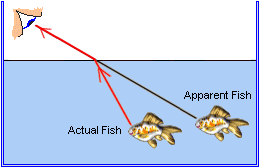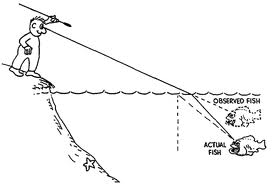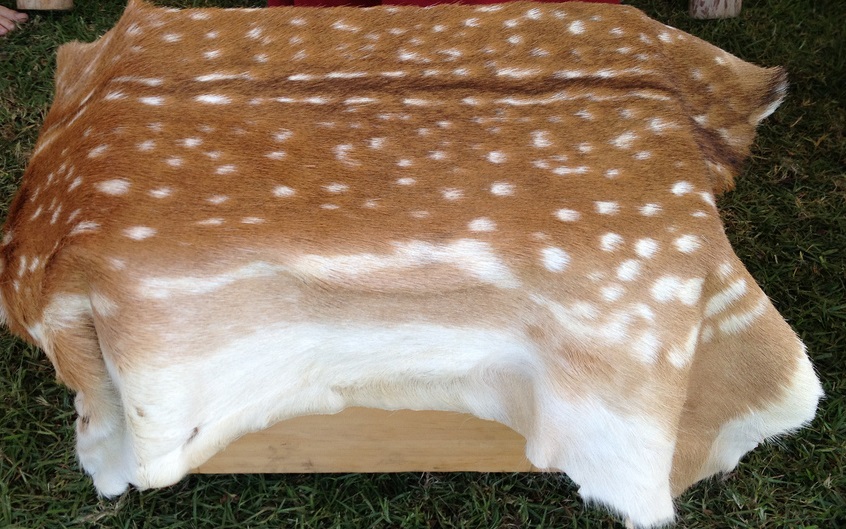Wilderness Survival – Spearing Fish in Water – Refraction
Hello and welcome again, to another exciting article. At least I hope it is exciting… or at the very least ultimately enthralling. I would like to take a moment to discuss the following skill: spearing fish. When stuck in the wild by circumstance or self choice, you will need to eat. If you pay attention and have the proper knowledge there are multiple vegetarian options you can find almost anywhere.
There are edible plants; If you have the confidence of knowledge to determine the difference between safe and poisonous species. There are berries, leaves, bark, and sap. You do not need meat to survive, that is important to note. If however there is a serious lack of plant life or you lack the necessary knowledge to determine which plants are safe to eat, you may want to try your hand at trapping or fishing.
Trapping we will discuss in future articles. Let’s say that today you want to try your hand at catching a few fish. If you have an appropriate survival knife this could be simpler than starting from scratch. If you have string and a hook or perhaps have a knife that carries these items within the handle, you might have it a little easier. Although sooner or later your line will break or your hook will come loose. This is not to say that you aren’t able to create more string or twine from plant life and a hook from various resources. It is just often easier at this point to spear a fish, spear fishing as it were.
This sounds amazingly much more simple than it is. Fish are fast. This is the first thing I would like to note. If the fish isn’t pregnant or extremely fat/sick then chances are it will be VERY quick. This isn’t the only obstacle, mice are tiny and fast but I might could spear one easier than a fish. Fish are under water. PAY ATTENTION TO THIS PART! To the average person, the fish being underwater may not seem important to the fishing aspect. “You just jab your spear in there and snag your fish right?” Wrong. Take a quick look at the following picture:
That’s right, refraction of light. You remember when you were a child (or last week) and you played with a prism? It’s like that. Light speed changes and the light “bends” when passing through different substances such as water. Substances of differing density change the level of refraction.
Snell’s law (also known as the Snell–Descartes law and the law of refraction) is a formula used to describe the relationship between the angles of incidence and refraction, when referring to light or other waves passing through a boundary between two different isotropic media, such as water and glass.
You won’t need to learn the equations or formula. If you are a math wizard who understands it and can apply it to the situation… great. Don’t expect to fare any better than the rest of us during spear fishing at first. Much practice is needed.
To break it down in layman terms, where the fish appears to be is not where the fish really is. In almost every case, the real fish is actually below the image you see resulting from the refraction. This is simple enough to understand, but if you didn’t have this knowledge it could be VERY frustrating. It’s hard enough to spear a moving target without it projecting illusions as well.
On To Technique
Like any kind of sport where you must hit a moving target, you first need to lead the target. Leading a target simply means aiming in front of it’s movement. If the fish is swimming to the left, and you aim at the fish’s mid-section, there are a few things that will happen in that split second of thrust. As soon as you start to thrust in your straight line, the fish has spotted you and those fight or flight reflexes work very quickly. The fish will put on a burst of speed and you will hit nothing but water. It is slightly harder for the fish to stop mid swim and turn around, at most it might turn slightly. Either way the fish will continue forward for that split second. You need to aim a few inches in front, or at least an inch depending on how fast the fish is already moving.
You lead the target, and of course due to refraction of light you will actually be aiming below the target. In front and below the moving target. Exactly where, is a technique you only learn with practice. Depending on your relation to the fish, the refraction angle will change. If you can get right above the fish, with a boat or by standing on a rock in the middle of a river you will have an advantage. By hovering over the fish, the fish image shouldn’t be refracted to such an extreme from the original. It will still appear closer to the surface than it really is, but you just need to thrust harder and deeper right?
 In an ideal setting with the best conditions I suggest a portion of river that is slightly shaded. Perhaps an overcast sky would be nice. Although rain is a good time to go fishing it can often make spearing a fish very difficult. You may prefer sun, but it’s best to experiment with different lighting conditions and shade until you find out which is easiest for you. If you aren’t able to float out to the middle of the river via raft/boat, then the best alternative is swimming out to an island or rock. From either of these you will hover over the water staying as still as possible. If you wait until you see the creature to poke your head over the water, the fish might spook. To minimize refraction, you would want to wait until a fish is almost directly under you. If moving you will still need to lead the fish slightly with your aim.
In an ideal setting with the best conditions I suggest a portion of river that is slightly shaded. Perhaps an overcast sky would be nice. Although rain is a good time to go fishing it can often make spearing a fish very difficult. You may prefer sun, but it’s best to experiment with different lighting conditions and shade until you find out which is easiest for you. If you aren’t able to float out to the middle of the river via raft/boat, then the best alternative is swimming out to an island or rock. From either of these you will hover over the water staying as still as possible. If you wait until you see the creature to poke your head over the water, the fish might spook. To minimize refraction, you would want to wait until a fish is almost directly under you. If moving you will still need to lead the fish slightly with your aim.
When it comes down to it, you make the appropriate calculation in your head as to where the fish is and strike. Two hands on the spear, one near the butt end and one towards the front. The back hand is your thrusting hand which provides the force. The hand in front keeps your aim true. I would experiment when you get a chance to be around a river or body of water. Try slowly putting a stick or straight object into the water while standing on the shore. Pick out a rock or plant in the water as a target and watch how the refraction of light actually works.
In my opinion the refraction is actually your biggest enemy. You will often find stationary fish enjoying the sun having a nice fish nap. Finding a fish floating in one place isn’t always a problem; creating a spear isn’t much of a problem, and a moving target isn’t the biggest trouble either. A fish being in a completely different place than it seems, that will cause trouble.
This takes experimentation to get right. I strongly recommend that you learn edible plants and berries to keep hunger at bay while you get the hang of this. Even if you have practiced before, you will have to get back in the swing of things. Keep in mind that you are able to go much longer without food than without water. You won’t starve in just a few days. Drink water, stay hydrated and eat what you can. Learn to spear fish as you have time. If you aren’t good at it now, a few weeks of nothing but plants, berries and bark will make you an expert.
You can’t teach instinct or muscle memory. Being a magician and a fast typist I can tell you this. I don’t look at the keyboard, in the same way when I pick up a deck of cards… my hands start going automatically. The same with any art or skill. After a while in the wild, spearing fish, it would be second nature. As long as you are interested and it appeals to you. I recommend you practice now, it’s a fun way to pass time while camping. Especially if you love fish and get tired or occasionally bored of fishing the traditional way.
Most tribes who did this or still do, did not throw spears such as shown in the movie “castaway” as far as I know. You don’t want to lose a spear or damage it. Wood can already be fragile and if you spent time carving your spear point… why waste the time by breaking it? If you have improvised a spear from your survival knife, I strongly advise NO THROWING of your one lifeline and strong metal tool.
Practice, practice, and enjoy your fish!
Also… of course if you would like to make a survival spear to practice with, this might be most authentic. Use a spare survival knife and strap it to a shaft like you would or whatever method you prefer. Another viable option to get the spearing action and accuracy down, would be to purchase one for now:
You can see one of those linked, is a product I have reviewed before, it isn’t the best at being a standalone knife but screwed onto a wooden broom shaft it works fine as a spear. On second thought, unless the fish are fairly large, it is REALLY recommended to use a barbed tip. For spear fishing specifically, as opposed to hunting a land mammal, carving the tip of your wooden shaft into barbs might be your best bet (as opposed to strapping a survival knife to it).
-Matthew Pizgatti




